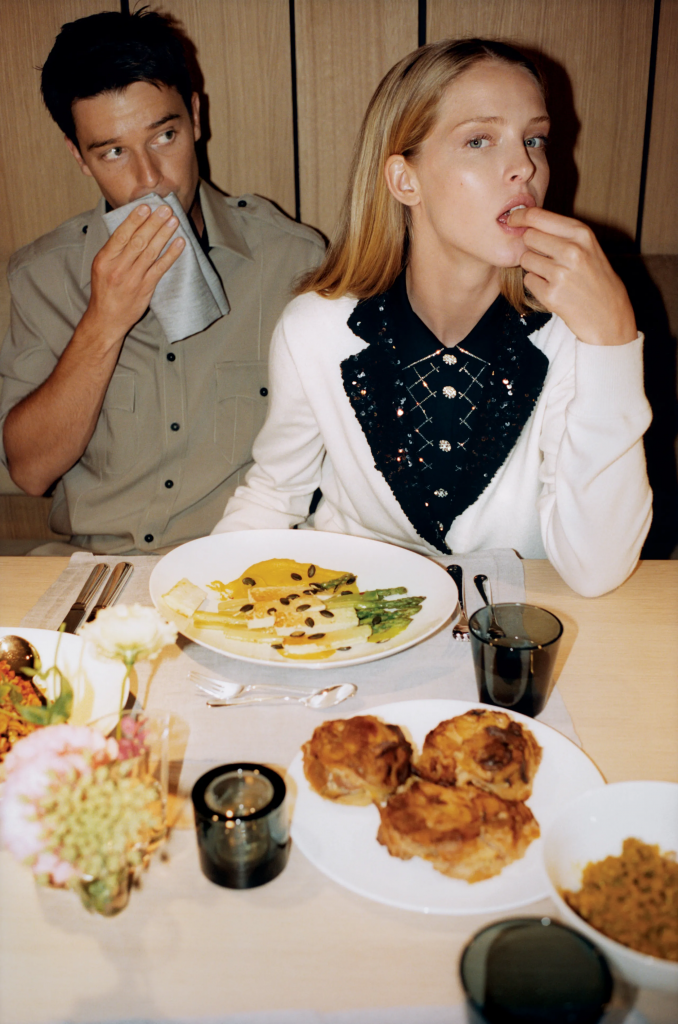“‘Sit up straight,’ said mom to Mabel, ‘and keep your elbows off the table!’” This was the silly, somewhat nonsensical rhyme my stepmom used to reprimand us with whenever our table manners got out of line. My brothers and I still chant it now—in jest, of course. For one thing, we’re adults, and for another, who cares anymore? To pull someone up for leaning a casual elbow on the table as they reach for a few more fries feels as outdated as critiquing them for mishandling a grapefruit spoon.

In fact, it’s worse than outdated; it feels actively rude, a form of class-based snobbery akin to mocking hand-me-downs or regional accents. Which is why, when a recent U.K. survey declared certain table manners were “a thing of the past,” I was neither outraged nor surprised. According to the British restaurant chain Prezzo, “almost three quarters (73 percent) of Brits believe people care less about table manners compared to previous generations,” or so they found when they polled 2,000-odd diners.
As for what those table manners include: there are the aforementioned elbows on the table, which 77 percent of Gen-Z don’t care about; starting before other diners’ food has arrived (38 percent don’t care); using a knife and fork “correctly” (77 percent don’t care); and eating off each other’s plates (37 percent don’t care). You could argue, as many will, that this is yet more proof we’re headed to hell in a handcart, or you could see it as a reflection of a more progressive, communal, and enjoyable dining scene.

Take those elbows, for example. The act of leaning in to better reach a dish or hear the conversation reflects enthusiasm for the whole dining experience. Ditto eating off someone else’s plate, which is arguably the result of our growing preference for a sharing-style approach to food. In the last 30 years, the dining landscape on both sides of the pond has transformed beyond all recognition. It’s more diverse, more inclusive, led by good produce rather than propriety. Starched white tablecloths have—for the most part—been replaced with easily cleaned marble or wooden tables, which are far better suited to sharing plates and their attendant splashes and spills.
Then there’s waiting for everyone else’s food to arrive before starting to eat yours, even though you can see its heat dissipating in front of you. Of course, in days of yore, it would have been rude to crack on while your fellow diners were still empty-plated—but that’s because their dishes would have been mere seconds away. In this boldly flavored new world, we’re told, food comes “when it’s ready”—and when it does, we all cry, “Start, please, while it’s hot!” to the lucky recipient. That’s assuming, of course, that we’re not splitting it with them—which, let’s face it, is highly likely. We live in a city in which even pasta and cocktails are designed to be shared.
This isn’t a mark of disrespect towards those we’re eating with; it’s a mark of respect for the quality of the food and the restaurant experience. Most of us don’t eat out because we’re incapable of cooking or to see or be seen anymore; we eat out for the love of the atmosphere and the dishes being served. To that end, the manners that matter are those that enhance this experience, such as offering around the last croqueta before nabbing it—a custom only 13 percent of diners overlook, apparently. It’s telling, too, that the few things we still apparently regard as non-negotiable are those that pertain to conviviality and basic hygiene rather than propriety. Talking with food in your mouth, snapping your fingers at servers, and being overly loud in a restaurant are “the rudest things you can do whilst out for a meal” according to the majority of those surveyed—closely followed by using your phone.
For me, it’s the last one that’s a real sticking point – and the one breach of etiquette that almost everyone I know is guilty of. “Sorry, do you mind if I just…” we mutter, as we go ahead and take a call or snap a photo. It’s a “real buzz barrier” one restaurateur told me; “an insidious presence” complained another. It is the opposite of conviviality (and hygiene, too, given how many germs phones carry), and we all know it.

Of course, one could argue that this behavior is also a reflection of the quality of restaurant food these days. When dishes are as Instagrammable as they are now, we’re going to take photos of them; when menus feature ingredients we don’t recognize, we can surely be forgiven for looking them up. Eating out has become a more interactive experience generally, and most people I know are more capable of googling than putting their phones away.
But while I’m as guilty as the next punter, I think the problem of phones at the table is one of those few rules that transcend class, countries, and culture. It offends something at our very core. So I welcome the wane of certain, silly table manners. I’ll happily put my elbows on the table and steal a chip from someone else’s plate using my fish fork. But in embracing the emergence of a more elbow-lead, don’t-hold-back approach to feasting, we should be wary of the thing that most threatens it. Put your elbows on the table by all means, Mabel—but put away your phone.
Cre: VOGUE





